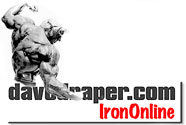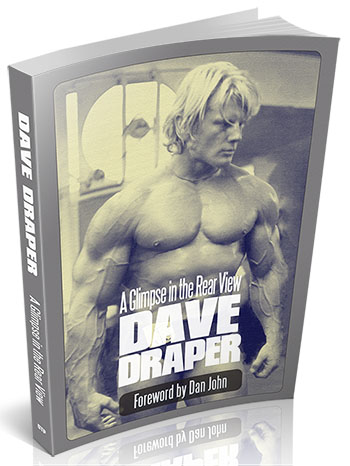HIT and Heavy Duty Training
A
Brief Primer on High Intensity Training
Page 4 of 4
Written by Steve Wedan
That approach has undergone considerable change, too, though. He now emphasizes the desirability of long cycles and small incremental increases in poundage to keep progression going and going. To allow this, he advocates the use of very small discs, which he calls, "little gems." In a "single progressive" system, these tiny weights add up over weeks and months and really do allow increases in strength and size that are measurable and pretty consistent. While I prefer the double progressive system -- the repetitive cycling of both reps and poundage -- and the use of shorter cycles, the logic of Stuart's approach is hard to criticize. With an eye toward the end result you are working for, this steady progression is uniquely gratifying. In fact, he doesn't really talk about cycles much anymore; it's more a focus on steady, incremental progression. Up and up and up.
Although the progress seems slow when one first hears/reads it described, it actually is quite fast, compared to the progress of others in the gym. In fact, there is a large percentage of people in the gyms I've gone to who don't progress at all after reaching a certain plateau.
Stuart also is big on each person becoming his own expert, personal trainer. Properly educating oneself with facts and different trainers' personal insights, both of which are supplied in bulk both in his books and his magazine, a man learns to consider his lifestyle, genetic factors, recovery rates, history of injuries, conditioning goals, and joint leverages to create his own best program. There is no such thing as a "one size fits all" mentality. And the same goes for a woman: Her training needs are likewise met when she comes to the same sort of understanding.
The other main emphasis (besides progression) Stuart makes is his insistence on perfect exercise form. He has experienced several injuries in his lifting career, one gotten while performing a set of deadlifts, 400 pounds for 20 reps. That is an accomplishment which still astounds me, especially considering the fact that Stuart's not a natural muscleman. He's as average as I am. He set a goal and reached it. But he got injured.
So now, when you read his writings, you come away with several impressions: Safety comes first when lifting; average people can gain great amounts of muscle and might; genetic supermen have set examples not to be followed. His books are, in my opinion, the best ever published on the practicalities of muscle building for those of us not blessed with natural advantages and not using growth-enhancing drugs.
It would be impossible to write a typical McRobert-style workout, because there is so much variation. The catch-words, though, are "basic" and "abbreviated." Progressive would also apply. The key to progress is not putting super-human effort into every set of every workout, although in the latter stages of a cycle, it becomes exactly that.
Here's what the keys really are: Get very good at a few big exercises; pile on the poundages over time; and do the reps in perfect, muscle-building form.
I should also mention that while Arthur Jones and his followers wrote about the roles both growth drugs and genetics play in the success of many of the bodybuilders we admire, Stuart McRobert was the first to hammer these things home with a vengeance. "Hammer" is a good verb, because Stuart doesn't stop. His overwhelming concern is for the common man and woman who, because they are genetically typical and refuse to resort to drugs to succeed, are in danger of being swayed by those unlike them. The elite grow on routines that at best don't work for those of us whose gains come hard; at worst, they cause us to weaken and get sick because of compromised recovery systems. Overuse injuries also lie in wait for the enthused but unwary average Joe or Jo. These simple truths must be fully grasped to succeed, because local heroes aplenty are in the gyms, and copying them can be the worst thing you can do, if your goal is to make your time with the weights productive.
All the people I've discussed can be reached on the Internet. Or their business concerns can, at any rate. I urge everyone to visit Stuart's web-site Hardgainer.com; I saved him for last for a purpose. He is as opinionated as anyone, but his opinions make the best sense to me and a lot of other people who have gotten frustrated with their training and nutrition, and have found the approach he espouses works. It works in spades. He's a decent man who's learned by making a lot of mistakes. The valuable thing for us is that what he's learned he communicates, and what he communicates are things that will bring the greatest benefits.
So, there you have it. High intensity training has several variations, from the high tech world of machines designed to provide "rotary and variable resistance" to basic work with increasingly heavy barbells. The underlying elements common to all of them are that sooner or later, they involve a high level of work over brief time, relative to more standard workouts; ample time for recovery is encouraged, enough to allow you to maintain steady progress in strength and muscle size; exercises that are multi-joint in nature and that have large ranges of motion are preferred over smaller moves, except for those done to strengthen stabilizing muscles (Stuart believes strongly in 'L-Flyes,' for example, in order to strengthen the muscles responsible for outward rotation of the shoulder, the muscles often injured after years of bench pressing); and abbreviation of routines is prized as a way of incorporating all of these.
A good example of a template for writing a high intensity routine would be to include one full-body move that emphasizes the hips and thighs, such as the squat or the deadlift. It also would include one pressing movement, one pulling movement, and an exercise each for the calves and abdominals. Supplementary movements, exercises you would consider temporarily dropping during the hard phase of a cycle, if you're cycling intensity a la Stuart McRobert, would include L-Flyes, a neck exercise, grip work, and possibly face-down incline shrugs, which build the muscle tissue that strongly stabilizes the back when lifting heavy.
Variation might be achieved by cycling your workouts. My approach is to alternate deadlifts and squats: One one week, the other the next; then, repeat. I also cycle pressing and pulling moves: Overhead pressing one week, dips the next; pulldowns one week, braced rows the next. Because arms are the weak link in any pressing or pulling exercise, I follow a hard pressing workout with a short, focused effort on triceps. Likewise, I often follow a heavy pulling workout with both curls and grip work. The cumulative visual effect on my musculature is superior to that I achieved in the days when the volume of my routines was greater. The reason is that I am bigger when I lift this way. Eating properly, I also remain reasonably lean.
One final thought is offered to those who might be considering abbreviated training but are afraid of not covering all the muscles of his body with the many exercise choices at his disposal. There is a concept called Indirect Effect, something the immensely powerful Paul Anderson used to write about, and which later was picked up by Arthur Jones. It is extremely important, but few in modern bodybuilding are even aware of it, much less rely on it.
Indirect Effect is the effect any particular exercise has on the rest of the body. Everyone's heard that squats effect the whole body, even parts not directly worked by the exercise, but often, little further thought is given to the concept. Basically, the bigger the muscle mass worked by the exercise, the greater the growth effect it has on adjacent muscles. Along with that is this: The effect is stronger on closer muscles.
So, squats will benefit your arms, even though the work on your arms is negligible in the squat. It's caused by Indirect Effect. It will also cause growth in your forearms, even if the only movement you ever did was squats, with no other exercises. But the growth in your forearms will be less than the growth in your upper arms because the forearms literally are farther away from the working hips, thighs and back muscles.
No one knows exactly how this happens, but it happens. This is useful to you when you're dealing with the economics of muscle growth. Arnold might grow from squatting all day in the forests of Germany, but you almost certainly won't, and that difference has everything to do with his genetic potential: He can recover from work you probably cannot. I certainly cannot. But you can grow from a few sets of squats. In fact, you probably will grow from doing them. But while Arnold back in 1970 might do three "Torture Routines" per week for his thighs, you are almost certainly better advised to squat once or twice a week and make those workouts MEAN something to you. Then rest and eat.
Applied to your whole body, you'll see the logic behind doing abbreviated workouts, in the context of Indirect Effect. Dips will build your pecs and triceps, but the delts are going to grow, too. As will your lats, to a certain extent (those lats not only are close to large working muscles during dips, but they also play a role in bringing your arms from a position of elbows-behind to elbows-in-front-of your torso). Combine this with pulldowns, and overhead presses and rows over several days, and you get complete work for your torso. Obviously, other exercises can be chosen based on past injuries or preferences based on other factors. For example, you might be "married" to bench pressing. My preference of doing dips shouldn't constitute a ban on benching, by any means.
I could explain the concept of "noncontiguous innervation" and the folly of dividing many muscles into inner and outer or upper and lower, depending on the muscle group, but that is a discussion for another day. I just want to go on record to help those of you seeking real progress by saying that you don't need to do every exercise in the book for every muscle on your body. In fact, you'd better not try, if you're genetically average and you plan on buying bigger shirts in the near (or distant) future. You'll just wear yourself out and go on in a fruitless search for the perfect routine.
Lift progressively and lift perfectly. Then go get a lot of rest and sufficient nutritious food. I firmly -- and with good reason -- believe this formula will give you the best chance you've got of building the body of your dreams.
Click here to return to page one of the HIT primer
Steve
Wedan is an artist and writer. He also is a contributor
to the IOL Forum.
You can see and order his new print of Dave by clicking on this link.
Click here if you missed Steve's article on Arthur Jones and Casey Viator
Click here to catch up with Dr. Ken

